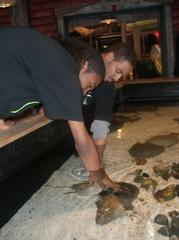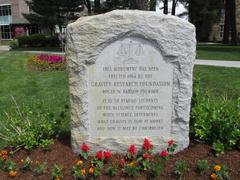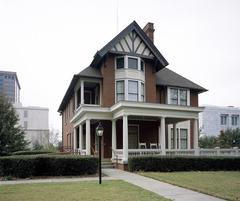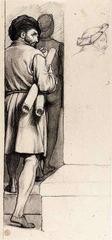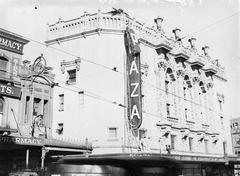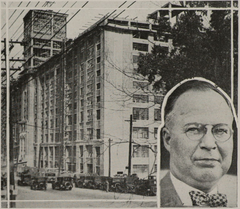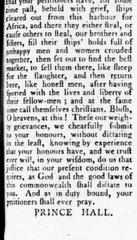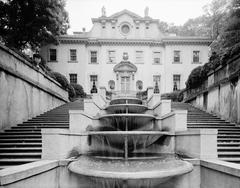Statue of Eugene Talmadge: Visiting Hours, Tickets, and Historical Significance in Atlanta
Date: 04/07/2025
Introduction
The Eugene Talmadge statue, located on the grounds of the Georgia State Capitol in downtown Atlanta, stands as a complex and significant symbol in Georgia’s historical and political landscape. Erected in 1949 and sculpted by Steffen Thomas, this bronze monument honors Eugene Talmadge, a four-term governor whose populist leadership and controversial segregationist policies left a lasting mark on the state. For visitors, the statue is not just an artistic landmark, but a catalyst for reflection on the evolving narratives of justice, memory, and public commemoration in Georgia.
This guide provides comprehensive information for anyone planning to visit the Eugene Talmadge statue, including location details, visiting hours, accessibility, historical context, and nearby attractions. Visitors will also find practical tips for making the most of their visit and resources for deeper exploration.
Table of Contents
- Location and Directions
- Visiting Hours and Admission
- Accessibility and Visitor Services
- About the Eugene Talmadge Statue
- Visitor Experience and Tips
- Nearby Attractions
- Conservation and Maintenance
- Frequently Asked Questions (FAQ)
- Summary Table of Key Capitol Monuments
- Conclusion and Visitor Recommendations
- References and Further Reading
Location and Directions
The Eugene Talmadge statue is positioned on the east side of the Georgia State Capitol grounds, at 206 Washington St SW, Atlanta, GA 30334. The site is easily accessible:
- By Public Transit: The nearest MARTA station is Georgia State, a short walk from the Capitol.
- By Car: Paid parking is available in nearby lots; spaces may be limited during legislative sessions.
- On Foot: The Capitol is centrally located and surrounded by paved, pedestrian-friendly walkways.
Clear signage and open landscaping make the statue easy to find among other notable monuments on the Capitol grounds.
Visiting Hours and Admission
- Capitol Grounds: Open daily from dawn until dusk.
- Capitol Building: Open Monday–Friday, 8:00 AM–5:00 PM.
- Admission: Free. No tickets are required to access the statue or the Capitol grounds.
Guided tours of the Capitol, which often include stops at the Talmadge statue, are available on weekdays through the Georgia State Capitol Visitor Center. Check the official website for tour times and schedules.
Accessibility and Visitor Services
- Wheelchair Accessibility: The grounds are fully accessible, with paved walkways and ramps leading to the statue.
- Restrooms: Available inside the Capitol building during open hours.
- Visitor Center: Offers interpretive materials, tour information, and assistance for visitors with special needs.
About the Eugene Talmadge Statue
Historical and Cultural Significance
Unveiled in 1949, the statue commemorates Eugene Talmadge, who served as Georgia’s governor during the 1930s and 1940s. Talmadge was known for his populist rhetoric and staunch opposition to federal intervention, but his legacy is marred by policies that promoted segregation and white supremacy. Controversies during his tenure included the 1941 “Cocking Affair” and his connection to the 1946 Moore’s Ford lynching (flagpole.com). The statue stands as both a memorial to his political influence and a focal point for ongoing debates about historical memory.
Artistic Features and Design
German-American sculptor Steffen Thomas designed the statue in a neoclassical style, harmonizing with the Capitol’s architecture (trek.zone). The bronze figure stands in a commanding pose, dressed in a mid-century suit, and rests on a granite pedestal inscribed with Talmadge’s name and years of service. The orientation and scale (approximately 6–8 feet tall on a 12–15 foot pedestal) convey authority and visibility.
Controversy and Public Debate
The monument’s presence has been increasingly debated in recent years due to Talmadge’s segregationist policies and racist actions. Some activists and community leaders have called for its removal or relocation, echoing broader national conversations about monuments to controversial historical figures. The statue’s location near monuments to civil rights leaders, such as Martin Luther King Jr., highlights Georgia’s ongoing reckoning with its past.
Visitor Experience and Tips
- Best Time to Visit: Spring and fall offer the most pleasant weather; early morning or late afternoon provides optimal lighting for photography.
- Guided Tours: Weekday guided tours offer valuable context about the statue and the Capitol’s history.
- Photography: Permitted and encouraged. The plaza area facing the Capitol dome provides the best backdrop.
- Etiquette: Be respectful, particularly during public demonstrations or commemorative events, which are common on Capitol grounds.
Nearby Attractions
Enhance your visit by exploring other significant sites in the immediate area:
- Liberty Plaza: A public gathering space for rallies and events, adjacent to the Capitol.
- Miss Freedom: The statue atop the Capitol dome, a symbol of Georgia.
- “Expelled Because of Color” Sculpture: Honors African American legislators expelled from the Georgia General Assembly in 1868.
- Martin Luther King Jr. Statue: Celebrates the civil rights leader’s legacy.
- Centennial Olympic Park and Atlanta History Center: Both are within a short drive or walk.
Cafés and restaurants can be found nearby, especially along Mitchell Street and the Fairlie-Poplar district.
Conservation and Maintenance
The Talmadge statue is maintained by the Capitol grounds staff, who conduct regular cleanings and apply protective treatments to preserve the bronze and granite materials. These efforts ensure that the monument remains visually striking and structurally sound for future generations.
Frequently Asked Questions (FAQ)
Q: Is there an admission fee or are tickets required to visit the statue?
A: No, visiting the statue and Capitol grounds is free and does not require tickets.
Q: What are the visiting hours for the Eugene Talmadge statue?
A: The statue and grounds are open daily from dawn until dusk.
Q: Is the site wheelchair accessible?
A: Yes, there are ramps and paved walkways suitable for wheelchair users.
Q: Can I take photos of the statue?
A: Yes, photography is allowed.
Q: Are guided tours available?
A: Yes, free guided tours of the Capitol are available on weekdays and include information about the statue.
Q: What other historical sites are nearby?
A: Liberty Plaza, the Miss Freedom statue, the “Expelled Because of Color” sculpture, and the Martin Luther King Jr. statue are all within easy walking distance.
Summary Table: Key Monuments at Georgia State Capitol and Their Controversies
| Monument | Year Installed | Figure Represented | Controversy/Legacy | Current Status |
|---|---|---|---|---|
| Eugene Talmadge Statue | 1949 | Governor Eugene Talmadge | White supremacist policies, linked to lynching | Standing, debated |
| John Brown Gordon Equestrian | 1907 | Confederate General, KKK | Defense of slavery, Klan leadership | Standing, debated |
| Richard Russell Statue | 1972 | U.S. Senator | Opposition to civil rights, white supremacy | Standing, debated |
| Joseph E. Brown Statue | 1928 | Governor, Justice | Profited from convict labor, anti-miscegenation laws | Standing, debated |
| Martin Luther King Jr. Statue | 2017 | Civil Rights Leader | Symbol of progress and inclusion | Standing, celebrated |
| Thomas E. Watson Statue | 1932–2013 | Senator, Populist Leader | Racist, antisemitic rhetoric | Removed (2013) |
(Creative Loafing, trek.zone, Georgia State Capitol official site)
Conclusion and Visitor Recommendations
A visit to the Eugene Talmadge statue offers a unique lens into Georgia’s multifaceted history. The statue is not only an artistic landmark but also a prompt for reflection on the state’s journey from segregation to civil rights. Its placement among other monuments—including those honoring Martin Luther King Jr. and the “Expelled Because of Color” sculpture—highlights the tensions and progress within Georgia’s collective memory.
For a richer experience, combine your visit with guided tours and exploration of the Capitol Visitor Center’s educational resources. Nearby attractions, such as Centennial Olympic Park and Liberty Plaza, further enhance your understanding of Atlanta’s heritage. Stay informed about visiting hours and special events through official channels, and consider downloading the Audiala app for guided audio tours and real-time updates.
Ultimately, the Eugene Talmadge statue stands as a reminder of Georgia’s political legacy and a catalyst for ongoing dialogue about public remembrance. Visitors are encouraged to approach the monument with curiosity, respect, and a willingness to engage with the complexities of history.
Visuals and Interactive Media
Internal Links
External Links
- Georgia State Capitol Official Website
- Georgia State Capitol Visitor Center
- Georgia Tourism Board
- Atlanta MARTA Transit
- Wikipedia: Statue of Eugene Talmadge
- VisitSights Atlanta Tours
References and Further Reading
- Eugene Talmadge Statue: Visitor’s Guide to a Georgia Historical Monument, 2025, Audiala Research Data (Georgia State Capitol Official Website)
- Visiting the Eugene Talmadge Statue at Georgia State Capitol: Hours, History, and Tips, 2025, (trek.zone)
- Visiting the Eugene Talmadge Statue in Atlanta: Hours, Tickets, and Historical Context, 2025, Creative Loafing and Georgia State Capitol official site (Georgia State Capitol Official Website)
- Visiting the Eugene Talmadge Statue: Hours, History, and Nearby Atlanta Attractions, 2025, Wikipedia and Atlanta Historical Sites (Wikipedia: Statue of Eugene Talmadge)











